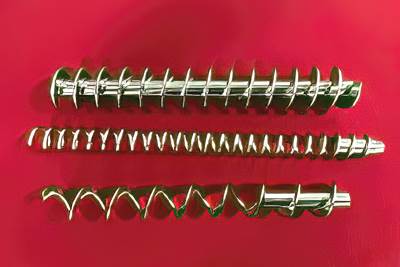Bulk, Solid and Melt Density: How to Calculate These Values and Why They Matter — Part 1 of 2
How much resin is contained within a bucket, gaylord or hopper? That depends on the bulk density — a figure you need to learn how to calculate due to its impact on everything from storage and conveying to drying and molding.
Knowledge of three types of densities related to plastic material is required in injection molding. These types are: bulk density, solid density and melt density. This two-part article will discuss each of these and provide an easy way to calculate these densities. As a basic definition, density is quantified as how closely the molecules of the material are packed together. The closer they are, the higher the density, or, in other words, there are more molecules in a given volume. The measuring unit is weight per volume, which is discussed below.
Bulk Density: Resin is usually supplied in pellet form from the material supplier. These pellets can have different shapes, ranging from spherical beads to somewhat flattened beads to simply cut extrudates forming small cylinders. The bigger the pellets are, them more empty space there will be between them. The size therefore causes a difference in the total weight of the plastic in a given volume. For example, consider the same grade of ABS supplied in smaller size and larger size pellets as shown in Figure 1.

Source: FimmTech
The weight of the total plastic with the smaller pellets will be more than the one with the bigger pellets. Please note that this is true with pellets sizes used in injection molding, extrusion, blow molding and similar processes but should not be used for any materials supplied in any other form.
Bulk density is defined as the amount of raw material present in a given volume and is most commonly measured in pounds per cubic feet (lb/cu ft) or kilograms per liter (kg/l). The reason for these units will become clear after an explanation of why bulk density is needed. Bulk density is also given in grams per cubic centimeter (g/cc), but that can often be confusing and also not very accurate when used in calculations — think about the number of digits required after decimal place. The method of calculating the bulk density is very simple.
- Take a container, such as a bucket, and calculate its inner volume.
- Weigh the container.
- Fill the container with plastic pellets and weigh the container again.
- Calculate the weight of the plastic pellets by subtracting the empty container weight from the full container weight.
- Divide the weight of the pellets by the container volume to get the bulk density value, so that: Bulk density = Weight of the plastic / Volume of the container.
As an example in Figure 2, a bucket with a diameter of 11.5 inches was filled with acrylic pellets to a height of 12.5 inches. Using the formula:
V = 0.785 ×X D × H
where D is the inner diameter of the bucket and H is the inner height of the bucket, the volume of the filled bucket is 1297.7 cubic inches or 0.75 cubic feet. After the weight of the bucket was subtracted from the weight of the bucket full of plastic, the weight of the pellets was calculated to be 27.27 lbs. Based on the calculation above, the bulk density of these pellets is 36.4 lb/cu ft.

The size and shape of the pellets play a major role in bulk density. There is no correlation between the bulk density and solid density of the material. (We will be discussing solid density in the next part of this two-part series.) The value of the bulk density is an important number to consider when sizing hoppers, dryer hoppers and storage silos. Every hygroscopic resin has a minimum and maximum recommended drying time. Based on the required throughput per hour, a calculation will be needed to have a minimum and maximum size (volume) of the dryer. Here the bulk density should be used for the calculation. Dryer manufacturers will size their equipment based on bulk densities.
Gaylords are of standard sizes and a material manufacturer needs to know how many gaylords will need to get shipped to a customer to deliver a certain amount of material. If the customer orders 1000 pounds, then the lower the bulk density means the higher the number of gaylords that will be required, with the reverse true as well. Transportation costs could get impacted, as will the storage space required in the warehouse.
Pellet sizes are very important for the conveying of the resin not only through the lines from the dryers to the machine feed throat but also for feeding into the machine and on to the feed zone of the screw. Consider micromolding machines where screw diameters can be as small as 15 mm. The pellets must fall into the feed section via gravity and then get conveyed further. A larger pellet size may not fall all the way into the feed section causing blockages and/or inconsistency in molding. In the second part of this series, we will discuss solid density and melt densities.
ABOUT THE AUTHOR: Suhas Kulkarni is the founder and president of FimmTech, San Diego, an injection molding service-oriented firm focusing on Scientific Molding. FimmTech has developed several custom tools that help molders develop robust processes, and its seminars have trained hundreds of individuals. Kulkarni is an author of the best-selling book, “Robust Process Development and Scientific Molding,” the third edition of which was published by Hanser Publications. Contact: 760-525–9053; suhas@fimmtech.com; fimmtech.com.
Related Content
Back to Basics on Mold Venting (Part 1)
Here’s what you need to know to improve the quality of your parts and to protect your molds.
Read MoreThree Key Decisions for an Optimal Ejection System
When determining the best ejection option for a tool, molders must consider the ejector’s surface area, location and style.
Read MoreThe Effects of Stress on Polymers
Previously we have discussed the effects of temperature and time on the long-term behavior of polymers. Now let's take a look at stress.
Read MoreWhy Shoulder Bolts Are Too Important to Ignore (Part 1)
These humble but essential fasteners used in injection molds are known by various names and used for a number of purposes.
Read MoreRead Next
What to Know About Your Materials When Choosing a Feeder
Feeder performance is crucial to operating extrusion and compounding lines. And consistent, reliable feeding depends in large part on selecting a feeder compatible with the materials and additives you intend to process. Follow these tips to analyze your feeder requirements.
Read MoreProcess Capability and the ‘Hesitation Effect’
Understanding the concepts of pack and hold and applying them during process development is critical for molders to achieve consistent part quality.
Read More



















